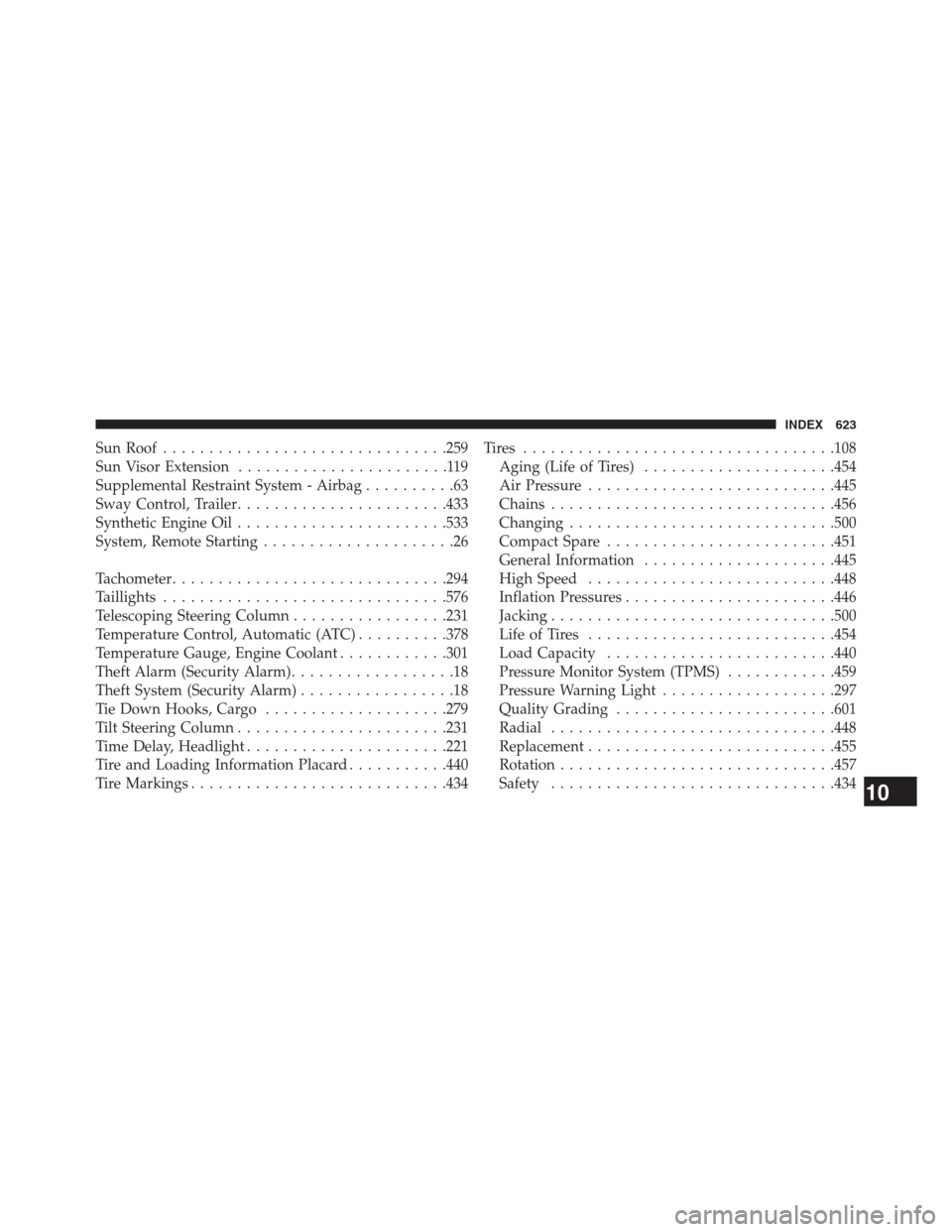Page 481 of 630

VEHICLE LOADING
The load carrying capacity of your vehicle is shown on the
“Vehicle Certification Label.” This information should be
used for passenger and luggage loading as indicated.
Do not exceed the specified Gross Vehicle Weight Rating
(GVWR) or the Gross Axle Weight Rating (GAWR).
Vehicle Certification Label
Your vehicle has a Vehicle Certification Label affixed to
the drivers side “B” Pillar or the rear of the driver ’s door.
The label contains the following information:
•Name of manufacturer
•Month and year of manufacture
•Gross Vehicle Weight Rating (GVWR)
•Gross Axle Weight Rating (GAWR) front•Gross Axle Weight Rating (GAWR) rear
•Vehicle Identification Number (VIN)
•Type of Vehicle
•Month Day and Hour of Manufacture (MDH)
The bar code allows a computer scanner to read the VIN.
Gross Vehicle Weight Rating (GVWR)
The GVWR is the total allowable weight of your vehicle.
This includes driver, passengers, and cargo. The total load
must be limited so that you do not exceed the GVWR.
Gross Axle Weight Rating (GAWR)
The GAWR is the maximum capacity of the front and rear
axles. Distribute the load over the front and rear axles
evenly. Make sure that you do not exceed either front or rear
GAWR.
5
STARTING AND OPERATING 479
Page 484 of 630

Gross Axle Weight Rating (GAWR)
The GAWR is the maximum capacity of the front and rear
axles. Distribute the load over the front and rear axles
evenly. Make sure that you do not exceed either front or rear
GAWR. Refer to “Vehicle Loading/Vehicle Certification La-
bel” in “Starting and Operating” for further information.
WARNING!
It is important that you do not exceed the maximum
front or rear GAWR. A dangerous driving condition
can result if either rating is exceeded. You could lose
control of the vehicle and have a collision.
Tongue Weight (TW)
The tongue weight is the downward force exerted on the
hitch ball by the trailer. In most cases it should not be
more than 10% of the trailer load. You must consider this
as part of the load on your vehicle.
Frontal Area
The frontal area is the maximum height multiplied by the
maximum width of the front of a trailer.
Trailer Sway Control – Electronic
Refer to “Electronic Brake Control System/Trailer Sway
Control (TSC)” in “Starting and Operating” for further
information.
482 STARTING AND OPERATING
Page 493 of 630

WARNING!(Continued)
•Total weight must be distributed between the tow
vehicle and the trailer such that the following four
ratings are not exceeded:
1. GVWR
2. GTW
3. GAWR
4. Tongue weight rating for the trailer hitch uti-
lized.
Towing Requirements – Tires
– Do not attempt to tow a trailer while using a compact
spare tire.
– Proper tire inflation pressures are essential to the safe
and satisfactory operation of your vehicle. Refer to
“Tires – General Information” in “Starting and Oper-
ating” for proper tire inflation procedures.– Check the trailer tires for proper tire inflation pressures
before trailer usage.
–
Check for signs of tire wear or visible tire damage before
towing a trailer. Refer to “Tires – General Information” in
“Starting and Operating” for the proper inspection
procedure.
– When replacing tires, refer to “Tires – General Infor-
mation” in “Starting and Operating” for information
on replacement tires and for the proper tire replace-
ment procedures. Replacing tires with a higher load
carrying capacity will not increase the vehicle’s GVWR
and GAWR limits.
Towing Requirements – Trailer Brakes
•Donotinterconnect the hydraulic brake system or
vacuum system of your vehicle with that of the trailer.
This could cause inadequate braking and possible
personal injury.
5
STARTING AND OPERATING 491
Page 494 of 630

•An electronically actuated trailer brake controller is
required when towing a trailer with electronically
actuated brakes. When towing a trailer equipped with
a hydraulic surge actuated brake system, an electronic
brake controller is not required.
•Trailer brakes are recommended for trailers over
1,000 lbs (454 kg) and required for trailers in excess of
2,000 lbs (907 kg).
CAUTION!
If the trailer weighs more than 1,000 lbs (454 kg)
loaded, it should have its own brakes and they
should be of adequate capacity. Failure to do this
could lead to accelerated brake lining wear, higher
brake pedal effort, and longer stopping distances.
WARNING!
•Do not connect trailer brakes to your vehicle’s
hydraulic brake lines. It can overload your brake
system and cause it to fail. You might not have
brakes when you need them and could have a
collision.
•Towing any trailer will increase your stopping
distance. When towing you should allow for addi-
tional space between your vehicle and the vehicle
in front of you. Failure to do so could result in a
collision.
492 STARTING AND OPERATING
Page 625 of 630

Sun Roof...............................259
Sun Visor Extension.......................119
Supplemental Restraint System - Airbag..........63
Sway Control, Trailer.......................433
Synthetic Engine Oil.......................533
System, Remote Starting.....................26
Tachometer..............................294
Taillights...............................576
Telescoping Steering Column.................231
Temperature Control, Automatic (ATC)..........378
Temperature Gauge, Engine Coolant............301
Theft Alarm (Security Alarm)..................18
Theft System (Security Alarm).................18
Tie Down Hooks, Cargo....................279
Tilt Steering Column.......................231
Time Delay, Headlight......................221
Tire and Loading Information Placard...........440
Tire Markings............................434Tires ..................................108
Aging (Life of Tires).....................454
Air Pressure...........................445
Chains...............................456
Changing.............................500
Compact Spare.........................451
General Information.....................445
High Speed...........................448
Inflation Pressures.......................446
Jacking...............................500
Life of Tires...........................454
Load Capacity.........................440
Pressure Monitor System (TPMS)............459
Pressure Warning Light...................297
Quality Grading........................601
Radial...............................448
Replacement...........................455
Rotation.............................
.457
Safety...............................434
10
INDEX 623